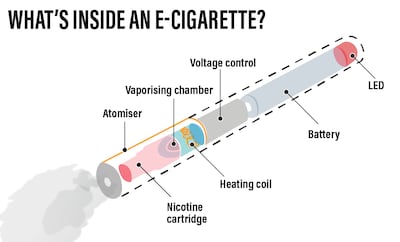Scientists and doctors have called for more research to back up a recent study indicating vaping could cause similar damage to mouth DNA cells as smoking tobacco – damage that could lead to cancer.
Researchers at University College London looked at samples swabbed from the cheeks of 4,000 vapers and smokers, to compare the impact of cigarettes and e-cigarettes.
Mouths exposed to tobacco and vape smoke were found to be substantially altered, leading to claims vaping may not be as harmless as first thought.
The changes measured in cheek cells were similar to the DNA methylation observed in cancer tissue, which is usually driven by lifestyle and environmental factors that suppress the genes responsible for preventing cells dividing into tumours.
Although the study does not directly connect e-cigarette use with cancer, it is the first reported study that reveals a potential link to its harmful effects.
“It is crucial to note that, while e-cigarettes do not contain tobacco, many do contain nicotine, which is derived from tobacco,” said Dr Soha Abdelbaky, a consultant medical oncologist at Medcare Hospital in Sharjah.
“Although e-cigarettes do not produce smoke like tobacco cigarettes, they may expose users to second-hand aerosol that may contain dangerous toxins.
“Nicotine in e-cigarettes may cause DNA alterations that promote cancer and tumour growth.
“E-cigarettes may also include harmful compounds including formaldehyde and N-nitrosamines, which have been linked to cancer.”
Aerosols
Cigarettes release combusted plant matter, which can send toxic chemicals directly into the lungs, resulting in lung tissue deterioration and cancer.
But while e-cigarettes do not produce a vapour to inhale, the aerosol emitted is made up of microscopic particles that users also inhale.
“The aerosol from an e-cigarette contains some cancer-causing chemicals, but in far lower concentrations than cigarette smoke,” said Dr Abdelbaky.
With few studies on the long-term effects of vaping, some said it is too soon to draw conclusions on a comparison with conventional smoking.
“It is still too early to link vaping with cigarettes, but of course, it is still harmful to the lungs,” said Dr Noordin Wadhvaniya, a pulmonologist at Canadian Specialist Hospital in Dubai.

Meanwhile, in the UK, where public health bodies said e-cigarettes are 95 per cent less harmful than combustible tobacco products, there has been a 26 per cent decline in cigarette use since 2011, according to the Office for National Statistics.
Experts responding to the vaping study, published by Cancer Research, said it lacked the depth required to make a significant link between vaping and cancer, and that e-cigarettes were still a less harmful option to help quit smoking.
“This interesting study shows e-cigarette use is associated with similar damaging changes in methylation in human cells as smoking,” said Professor Andrew Beggs, of the cancer genetics and surgery department at University Hospitals Birmingham
“Although it doesn’t show a direct causal effect, this study shows that further research must be done to understand the effects of e-cigarettes on human health and whether they could be linked to an increased risk of cancer.”
Smoking is the UK’s biggest preventable cause of death, costing the National Health Service around £17 billion a year.
Youth crackdown
Tough new measures on vaping are also due to come into force under the UK government’s tobacco and vapes bill, which aims to create a smoke-free generation.
Steps include new powers to restrict vape flavours, packaging and change how vapes are displayed in shops, plus on-the-spot fines to clamp down on sales to under-age people.

Figures from UK group Action on Smoking and Health revealed about 14 per cent of children had tried vaping in 2020, but that number had climbed to 20.5 per cent in 2023.
New Zealand is another nation tightening its approach towards vaping.
Those born on or after January 1, 2009, are already banned from purchasing tobacco, with disposable e-cigarettes or vapes also set to be withdrawn from sale.
Retailers selling vapes to those under 18 face fines of up to $60,000 (USD), while other regulations will prevent e-cigarettes being sold with images or names that are appealing to young people.
Despite that action, New Zealand’s health ministry backs e-cigarettes as a key smoking cessation device.
Speaking of the latest research on the potential harm of vaping, Prof Ross Lawrenson, a professor in Population Health at the University of Waikato, said more evidence would be needed to encourage those vaping to quit altogether.
“This new study suggests vaping is associated with epigenetic changes in the lining of the cheek,” he said.
“This could be a plausible explanation for a causal association with cancer, but so far we do not have any evidence that vaping does cause cancer.
“It’s important to note that smoking has been associated not only with lung cancer but also cancer of the larynx, oral cavity, lip, bladder and cervix.
“These findings are from a group mainly concerned with Women’s Health, and provide support for those who believe vaping will prove harmful.
“However the paper does not provide sufficient evidence of harmful outcomes that will be needed before the public will be convinced to stop.”







